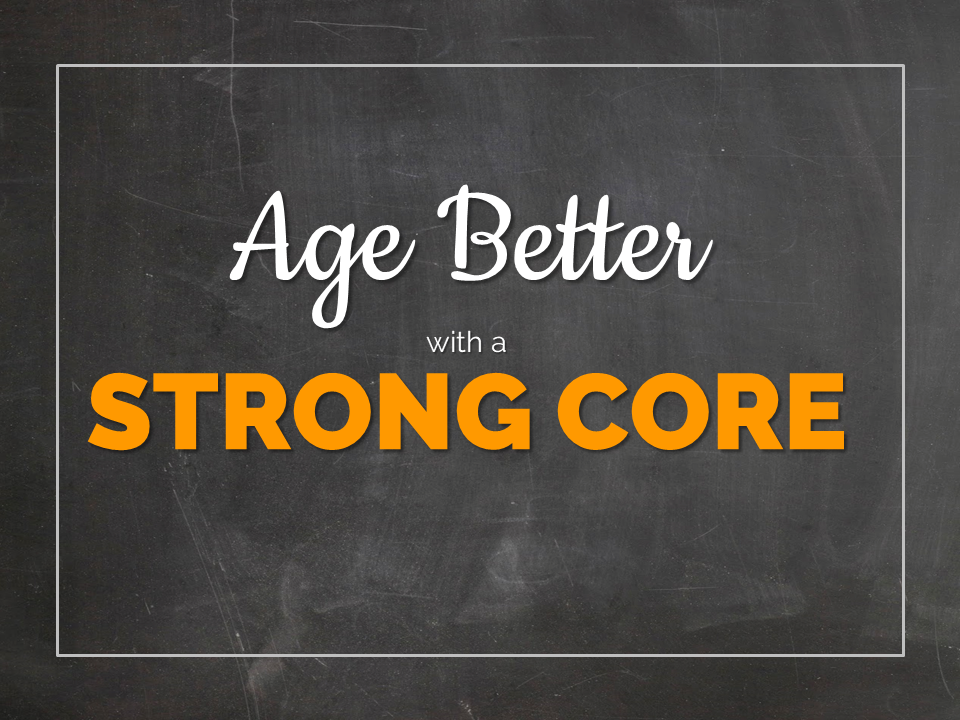There’s a lot of talk about the importance of having a strong core, especially as we age.
And maybe that’s a little worrying as you may not currently be the proud owner of a well chiseled 6-pack.
Luckily, you don’t need that kind of definition to have a strong core.
And, in fact, your core goes a lot deeper (and wider) than those superficial bumps.

So, what really is your CORE?
I like to think of the CORE like a barrel.
The front of your core (or barrel) is indeed made up of the obvious 6-pack, or rectus abdominis, but it also includes the deep transverse abdominis which is the girdle, or corset, underneath that helps keep your belly in check.
But your core also continues around your trunk, and is made up of the internal and external obliques at your sides, as well as the muscles in your lower back (lumbar multifudus, and erector spinae).
Then at the bottom of your core, you have your pelvic floor… That’s the net of muscles that connect to your bladder, bowel, and uterus, and it’s a common area of weakness for a lot of women in perimenopause.
Finally at the top of your barrel – or core – there’s your diaphragm, which is a thin layer of muscles that separates your abdominal cavity from your thorax, where your lungs are, and they help in breathing.
Why is your CORE important?
STABILITY
Your core provides the stability that allows you to move.
Every move you make like walking, getting up from a chair, and doing push ups, all require you to stabilize your core.
Notice next time you get out of chair how your core contracts to give you the stability to up and off the seat.
Without those muscles to anchor you, movement would be impossible.
BALANCE
For the same reason that your core stabilizes you, it also helps you keep your balance.
Standing on one leg destabilizes you.
Your other leg will need to work harder, but your core will also work hard to help keep you upright.
FLEXIBILITY
Not only should your core help you stabilize, it also needs to be flexible enough so you can move freely.
You need to be able to bend easily forward and back, as well as side to side without any major discomfort.
Not to mention have the ability to twist so that you do things like turn to see behind you, play golf and tennis, and shovel the driveway.
You’ll notice that if you want to bend to the right, the muscles on the left side of your core will need to stretch, they need to be flexible. But at the same time, the other core muscles will need to contract to stabilize that movement.
So both strength and flexibility are needed.
LESS LOWER BACK PAIN
Most people over 40 will have lower back pain at some point in their life.
It’s common, but it doesn’t need to be.
By keeping the core muscles strong and mobile, you can probably ward off this most common and immobilizing issue.
BETTER POSTURE AND MORE CONFIDENCE
When you’ve got good stabilization through your core, and your muscles allow you to move with ease, then chances are you’ve also got pretty good posture.
And because you’ll be standing taller physically, that will also lead to you standing taller emotionally.
Yes, you’ll feel more confident, just by having good posture.
Check out this Ted Talk by Amy Cuddy if you want to know more about that.
EASIER BREATHING
Practicing long, full breathing can help in keeping the diaphragm flexible and strong.
With your diaphragm working well, your breathing will be easier and you’ll be much efficient at bringing oxygen into your body.
BETTER BLADDER CONTROL AND MORE…
With a strong pelvic floor you can improve your bladder and bowel control, which is great news if urinary incontinence is an issue or a fear.
In addition, improving the strength of your pelvic floor can also improve your ability to reach and enjoy orgasm… Gotta love that, right?
So now that you know what a strong, mobile core can do, what can you do to get it that way?

What can you do to keep your CORE strong and mobile?
You need your core for pretty much everything you do, so I believe that working it every day is a smart idea.
And if lower back pain is an issue for you, this should be a non-negotiable.
Luckily, it doesn’t take much time to get a good workout… A few minutes can go a long way, with no special equipment is required.
And to help you, I’ve put together a little 10-minute Core Yoga routine you can do each day to both strengthen and lengthen the muscles of your core.
This workout includes plank and other stability exercises to strengthen your corset, and effective moves to challenge your balance.
It also includes spinal mobility as you’ll go through forward and gentle back bends, side bends and twisting.
Coordinated breathing is also part of this workout… As you move, you breathe.
In addition, although I don’t mention it in the video, it’s good to work the pelvic floor in concert with your breathing.
So every time you exhale, you can contract your floor (as if you’re holding back from peeing.) Every time you inhale, you can release it, allowing your lungs to take up more space.
One last word about your CORE…
It’s important to know that exercises for the CORE will strengthen the muscles, but they won’t necessarily burn belly fat.
Although you’ll definitely reduce belly fat through exercise and eating better, it ultimately depends on your body where fat will be burned.
So, in other words, lots of sit ups don’t add up to a smaller belly… But they can help you get a stronger one!
Was this blog post useful?
Let me know what you think in the comments below. Thanks!
And if you didn’t already, download my video “10-Minute Core Yoga” for a great little workout you can do daily.
Keep moving forward my friend,
Debbie


